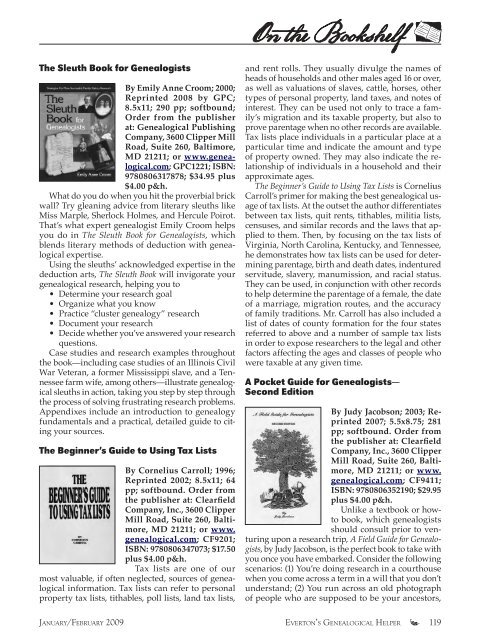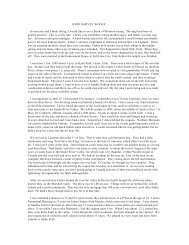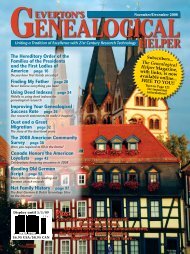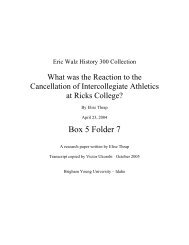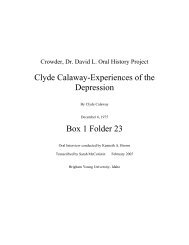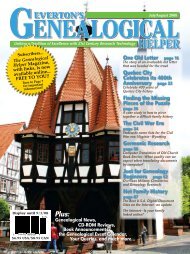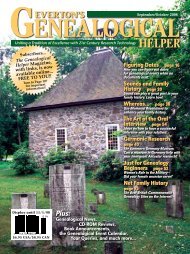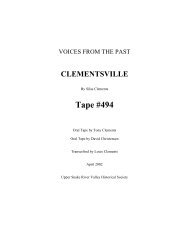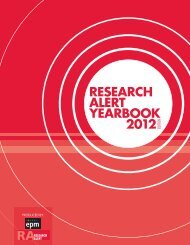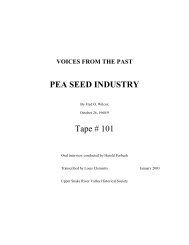HelPeR - BYU Idaho Special Collections and Family History
HelPeR - BYU Idaho Special Collections and Family History
HelPeR - BYU Idaho Special Collections and Family History
You also want an ePaper? Increase the reach of your titles
YUMPU automatically turns print PDFs into web optimized ePapers that Google loves.
On the Bookshelf<br />
The Sleuth Book for Genealogists<br />
By Emily Anne Croom; 2000;<br />
Reprinted 2008 by GPC;<br />
8.5x11; 290 pp; softbound;<br />
Order from the publisher<br />
at: Genealogical Publishing<br />
Company, 3600 Clipper Mill<br />
Road, Suite 260, Baltimore,<br />
MD 21211; or www.genealogical.com;<br />
GPC1221; ISBN:<br />
9780806317878; $34.95 plus<br />
$4.00 p&h.<br />
What do you do when you hit the proverbial brick<br />
wall Try gleaning advice from literary sleuths like<br />
Miss Marple, Sherlock Holmes, <strong>and</strong> Hercule Poirot.<br />
That’s what expert genealogist Emily Croom helps<br />
you do in The Sleuth Book for Genealogists, which<br />
blends literary methods of deduction with genealogical<br />
expertise.<br />
Using the sleuths’ acknowledged expertise in the<br />
deduction arts, The Sleuth Book will invigorate your<br />
genealogical research, helping you to<br />
• Determine your research goal<br />
• Organize what you know<br />
• Practice “cluster genealogy” research<br />
• Document your research<br />
• Decide whether you’ve answered your research<br />
questions.<br />
Case studies <strong>and</strong> research examples throughout<br />
the book—including case studies of an Illinois Civil<br />
War Veteran, a former Mississippi slave, <strong>and</strong> a Tennessee<br />
farm wife, among others—illustrate genealogical<br />
sleuths in action, taking you step by step through<br />
the process of solving frustrating research problems.<br />
Appendixes include an introduction to genealogy<br />
fundamentals <strong>and</strong> a practical, detailed guide to citing<br />
your sources.<br />
The Beginner’s Guide to Using Tax Lists<br />
By Cornelius Carroll; 1996;<br />
Reprinted 2002; 8.5x11; 64<br />
pp; softbound. Order from<br />
the publisher at: Clearfield<br />
Company, Inc., 3600 Clipper<br />
Mill Road, Suite 260, Baltimore,<br />
MD 21211; or www.<br />
genealogical.com; CF9201;<br />
ISBN: 9780806347073; $17.50<br />
plus $4.00 p&h.<br />
Tax lists are one of our<br />
most valuable, if often neglected, sources of genealogical<br />
information. Tax lists can refer to personal<br />
property tax lists, tithables, poll lists, l<strong>and</strong> tax lists,<br />
<strong>and</strong> rent rolls. They usually divulge the names of<br />
heads of households <strong>and</strong> other males aged 16 or over,<br />
as well as valuations of slaves, cattle, horses, other<br />
types of personal property, l<strong>and</strong> taxes, <strong>and</strong> notes of<br />
interest. They can be used not only to trace a family’s<br />
migration <strong>and</strong> its taxable property, but also to<br />
prove parentage when no other records are available.<br />
Tax lists place individuals in a particular place at a<br />
particular time <strong>and</strong> indicate the amount <strong>and</strong> type<br />
of property owned. They may also indicate the relationship<br />
of individuals in a household <strong>and</strong> their<br />
approximate ages.<br />
The Beginner’s Guide to Using Tax Lists is Cornelius<br />
Carroll’s primer for making the best genealogical usage<br />
of tax lists. At the outset the author differentiates<br />
between tax lists, quit rents, tithables, militia lists,<br />
censuses, <strong>and</strong> similar records <strong>and</strong> the laws that applied<br />
to them. Then, by focusing on the tax lists of<br />
Virginia, North Carolina, Kentucky, <strong>and</strong> Tennessee,<br />
he demonstrates how tax lists can be used for determining<br />
parentage, birth <strong>and</strong> death dates, indentured<br />
servitude, slavery, manumission, <strong>and</strong> racial status.<br />
They can be used, in conjunction with other records<br />
to help determine the parentage of a female, the date<br />
of a marriage, migration routes, <strong>and</strong> the accuracy<br />
of family traditions. Mr. Carroll has also included a<br />
list of dates of county formation for the four states<br />
referred to above <strong>and</strong> a number of sample tax lists<br />
in order to expose researchers to the legal <strong>and</strong> other<br />
factors affecting the ages <strong>and</strong> classes of people who<br />
were taxable at any given time.<br />
A Pocket Guide for Genealogists—<br />
Second Edition<br />
By Judy Jacobson; 2003; Reprinted<br />
2007; 5.5x8.75; 281<br />
pp; softbound. Order from<br />
the publisher at: Clearfield<br />
Company, Inc., 3600 Clipper<br />
Mill Road, Suite 260, Baltimore,<br />
MD 21211; or www.<br />
genealogical.com; CF9411;<br />
ISBN: 9780806352190; $29.95<br />
plus $4.00 p&h.<br />
Unlike a textbook or howto<br />
book, which genealogists<br />
should consult prior to venturing<br />
upon a research trip, A Field Guide for Genealogists,<br />
by Judy Jacobson, is the perfect book to take with<br />
you once you have embarked. Consider the following<br />
scenarios: (1) You’re doing research in a courthouse<br />
when you come across a term in a will that you don’t<br />
underst<strong>and</strong>; (2) You run across an old photograph<br />
of people who are supposed to be your ancestors,<br />
Ja n ua ry/Fe b r u a r y 2009 Ev e r t o n’s Ge n e a l o g i c a l He l p e r © 119


